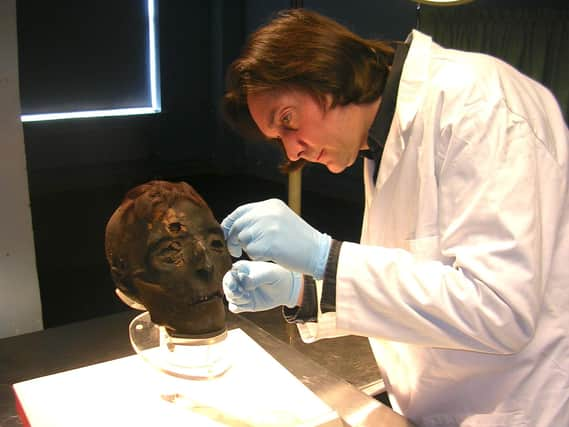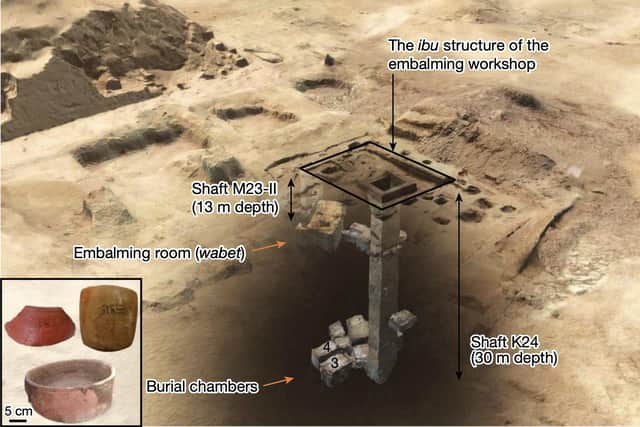Yorkshire ancient Egypt expert unwraps secrets of how to make a mummy


Animal fat, cedar oil, juniper resin, plant oils and beeswax were part of the recipe to make a mummy.
And some substances were imported from as far as tropical rainforests in Southeast Asia - giving new scale to the sheer size of the ancient Egyptian world.
Dr Stephen Buckley, of University of York’s BioArCh facility, was part of the team that have uncovered the new evidence, published in the journal Nature.
It follows extensive research into a 2,500 year old embalming workshop discovered in 2016 which contained jars inscribed with instructions such as 'to wash' or 'to put on his head'.
Helping to match the writings with traces of substances found inside the pottery was Dr Buckley.
A National Geographic TV documentary - watch here - featured him exploring the workshop with study author Ramadan Hussein, who discovered the workshop but passed away last year.
It is located in the famous burial grounds of Saqqara. Parts of it sit above the surface, but a shaft stretches down to an embalming room and burial chamber underground, where the jars were discovered.
Dr Buckley, of Scarborough, began his journey with a Chemistry degree at the University of Sheffield, recently also recently helped to discover how ancient Egyptians were embalming mummies 1,500 years earlier than previously known - around 6,000 years ago - using a plant oil, heated conifer resin, an aromatic plant extract and a plant gum/sugar mixed together on funerary textiles in which the body was wrapped.
He and and his partner, TV Egyptologist and University of York Prof Joann Fletcher, were part of a team of scientists who won a BAFTA for the Channel 4 documentary Mummifying Alan: Egypt’s Last Secret, which involved mummifying taxi driver Alan Billis, to replicate the ancient process at Sheffield’s Medico-Legal Centre.
They also made headlines as part of a team which got Nesyamun, known as The Leeds Mummy, to 'speak' after more than 3,000 years using an electronic larynx attached to a 3D print of a his voice box, scanned at Leeds General Infirmary.
Dr Buckley has been carrying out forensic tests looking for mummy remains in 19th century paintings featuring Mummy Brown paint, which included ground up remains of Egyptian mummies.
Of the embalming workshop discovery he says: “It’s the first physical evidence for the places where they worked.
"The substances themselves may have been selected precisely because they were hard to get. Some of the materials may have been used not because they were more effective, but because they were exotic.”
Prof Fletcher added: "This study is hugely significant, since it answers so many questions. Not only do we now have an example of the physical space in which the complex processes of mummification were carried out, but the labelled contents of the ceramic and stone vessels which were also found there.”
"And with the combined expertise of the Egyptian and European specialists working together, the words on the vessels have been translated and the chemical makeup of their contents finally established.


"It’s also important to realise that up until now, the only surviving written accounts for Egyptian mummification were composed by visiting Greeks, the main one being the historian Herodotus who described the process c.450 BC.
"One of the key things revealed by this study is the sheer size of the ancient Egyptian world - they were clearly trading enormous distances for these special commodities that were so crucial to their practice of preserving their dead.
"So although previous scientific studies had identified substances brought into Egypt from similarly far-flung regions, some within traditional Egyptology were reluctant to accept such findings and tended to ignore them. But the scale of the evidence provided in this new study will be very difficult to ignore, and I must say it is a fitting legacy to the late Dr. Ramadan Hussein, the study’s lead archaeologist."
* An Audience with Prof Joann Fletcher & Dr Stephen Buckley will feature the couple talking about their amazing careers to Graham Walker of The Yorkshire Post and The Star, at EnRich Auditorium, Barnsley Sixth Form College, St Mary’s Place, Barnsley on Thursday, March 16. For tickets visit www.cooper-gallery.com/whats-on/an-audience-with-prof-joann-fletcher-dr-stephen-buckley.
* Tut22: The Life of Tutankhamun, a temporary exhibition curated by Prof Fletcher, celebrating key Barnsley links which led to the discovery of the pharaoh's tomb 100 years ago, is open at Experience Barnsley Museum to Saturday, March 18. For details visit www.experience-barnsley.com/whats-on/tut-22-the-life-of-tutankhamun
* Resurrecting Ancient Egypt: A Monumental Yorkshire Journey, a Barnsley Museums touring exhibition of Kyte Photography photos highlighting Egyptian inspired Yorkshire architecture and also curated by Prof Fletcher, runs at Scarborough Art Gallery also to March 18, 2023. For more information visit scarboroughmuseumsandgalleries.org.uk/whats-on/event/resurrecting-anciet-egypt-a-monumental-yorkshire-journey.